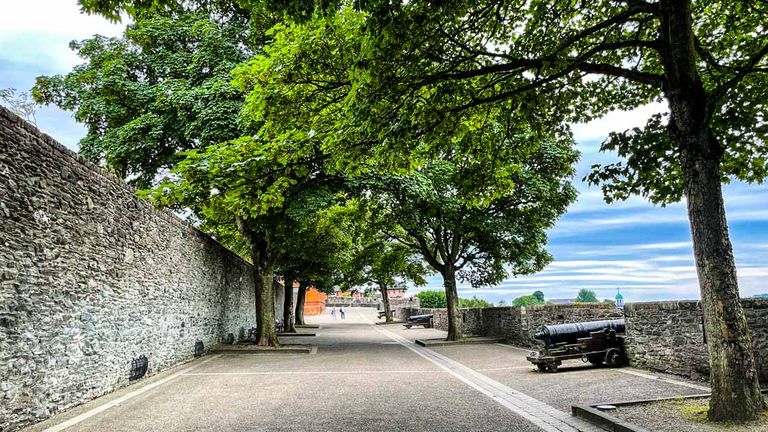Where is Derry?
Derry — also known as Londonderry — is located in Northern Ireland, a country in the United Kingdom. The second largest in Northern Ireland, the city offers plenty for clients, from museums and cultural attractions to pubs and restaurants.
Derry’s past is representative of the entire region’s turbulent history, but modern Derry is more than just its history: It’s a place where hope, humor, music, good food, excellent beer, artisan crafts and more engage visitors of all kinds.
It dates back thousands of years, but two wildly different events in the past half-century provide context for exploring today. The first is a shockingly brutal moment in 1972 known as Bloody Sunday, while the other is Lisa McGee’s endearing, often hilarious “Derry Girls” Netflix show, a pop-culture ode to coming of age in Derry in the 1990s.
Here’s your guide to exploring the past and present of the highly walkable, emotionally resonant city of Derry.
Historic Walls (and a “Derry Girls” Filming Location)
An intact, fully walled city, Derry is a rarity in Ireland, so begin your visit by exploring the area’s historic walls (it’s about a mile to walk the entire thing). For a city overview, book a Martin McCrossan City Walking Tour and explore with a guide whose commentary reveals much about Derry — and “Derry Girls.”
The wall is where character Orla McCool dances in season three, and where you can see the show’s iconic mural on the side of Badger’s Bar & Restaurant on Orchard Street. (Orchard Street is also where the girls chased not-dead Toto on his way to facilitating the infamous not-miracle.) The funeral scene for Clare Devlin’s father, meanwhile, was filmed outside St. Augustine’s Church along the wall; if the gate is open, the grounds offer a peaceful place to wander.
 At Badger's Bar and Restaurant, visit the iconic Derry Girl’s mural.
At Badger's Bar and Restaurant, visit the iconic Derry Girl’s mural.
Credit: 2023 Christine LoomisJust inside the wall, Tower Museum offers a deep dive into Derry’s history, interpreting its origins from pre-history times onward, including the Siege of Derry in 1689, when Protestant backers of William of Orange defeated Catholic backers of James ll, setting the stage for three centuries of sectarian conflict.
Must-See Landmarks
The most emotionally charged of the city’s cultural facilities is The Museum of Free Derry, which is located where riots in the 1960s ignited a 30-year period of violence known as “The Troubles.” Today, murals throughout the neighborhood depict incidents of Bloody Sunday but also signs of hope. The museum’s powerful exhibits and riveting historic audio and video footage bring Bloody Sunday and the days before and after into sharp, heart-wrenching focus.
And don’t miss a stop at the Guildhall, an architectural beauty with magnificent stained-glass windows and an ornate neo-Gothic exterior. Rebuilt many times, the building played a seminal moment in Northern Ireland history, when citizens voted on the Good Friday Agreement, and it was also the site of Prime Minister David Cameron’s 2010 apology and acknowledgement that the deaths on Bloody Sunday were “unjustified and unjustifiable.” The Guildhall is also where Orla registers to vote in the final season of “Derry Girls.”
 Check out Derry’s historic walls, which are a unique for Northern Ireland.
Check out Derry’s historic walls, which are a unique for Northern Ireland.
Credit: 2023 Christine LoomisThe evocative Peace Bridge, debuted in 2011 across the River Foyle, is worth a visit, too: It’s a visual ode to the promise and possibility of peace, connecting primarily Catholic and Protestant neighborhoods on either side of the river. There’s still development to come on the far side of the river, but an excellent reason to saunter across is Walled City Brewery, which offers excellent beer, food and hospitality. Check out the brewery’s humorous history-of-beer wall.
Where to Shop, Eat and Stay
Art lovers will enjoy Craft Village off Shipquay Street in Derry’s center, a collection of small shops featuring artwork and products created by local artisans. It’s a pleasant place to stroll, dine or sit even if you’re not shopping.
For a pint and a bite, head to Waterloo Street. Music pours out from open doors, where locals and visitors crowd around streetside tables. Some pubs are on the rowdy side but not all, and most evenings, you’ll find authentic Irish music somewhere. For a traditional “session” — where local musicians show up at a pub, instruments in hand, and sit in a circle playing traditional tunes — try lAn Bear Beag. An Irish dancer might unexpectedly start entertaining patrons, as happened the night I went.
I recommend a stay at the elegant Bishop’s Gate Hotel, well-located on Shipquay Street. Nearby is The Whatnot, a corner antique store loaded with great finds, and Hidden City Cafe, perfect for a vegetarian-friendly meal.
It’s easy to fall in love with this compact, history-rich city offering European charm and a visceral understanding of Northern Ireland’s past and present — and maybe its future, too, if the Peace Bridge fulfills its promise.
Best Side Trips From Derry
These destinations make for great side trips from Derry, and all are located about one hour’s drive from the city.
- Seamus Heaney HomePlace: Excellent exhibits on the life of Nobel Prize Laureate Seamus Heaney, who grew up near this center.
- Giant’s Causeway: Was this coastal geologic extravaganza created by nature, or tossed into existence in a fit by a mythic giant named Finn McCool? You decide.
- Glenveagh National Park: This evocative Irish landscape offers trails and a 19th-century castle with spectacular gardens.
- Mount Errigal: Hike as much or as little as you like of County Donegal’s highest peak.